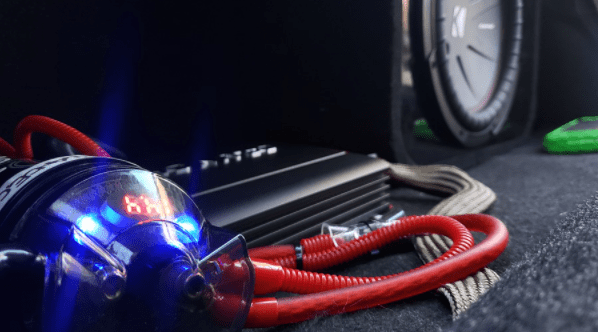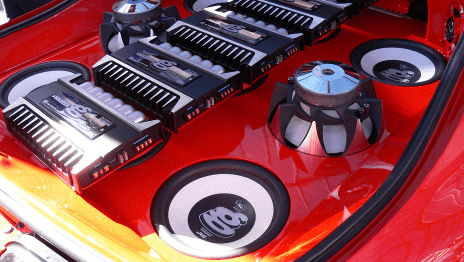A car amplifier is the heart of a car's stereo system. Sometimes it's not enough to just get the best speakers. You also have to get the right amp to power those speakers.
Say you want to replace your car amp. What do you do with the old one? Do you throw it away or sell it off? Definitely not!
If you probably weren't aware of this, you can use a car amplifier in your house as well! In fact, you can connect the car amplifier to any home stereo setup, even your smartphone. It is much more of an audio source than you can imagine.
Want to find out how? Read on and you'll know everything you need to connect a car amp to a wall plug of your house.
How to connect a car amp to a wall plug?

A car amplifier works just like any conventional home stereo system. The only differentiating factor is the power supply.
As you already know, the car amp is powered by the battery of the car. And the current produced by a battery is DC (Direct Current) power supply.
However, things are a little different when it comes to the current supply of homes. All the power outlets and wall plugs are AC power sources. Thus, all the electrical appliances running in your home operate on an AC power supply.
[So to use a car amp in your home and connect it to a wall plug, you only have to solve one issue – powering the amplifier.
The wall outlets in your home provide 110-volt AC power. Meanwhile, the car amp power is 12-volt DC.
And to fix this problem, all you need to do is a little wiring and you're good to go.]
Find out how by following the steps given below:
Understanding the power specifications of the car amp
Before initiating the installation process, it is crucial that you gather some important information about the car amp you want to use.
And to be very specific, you have to find out the input power specifications of the amp. Most of the time, you will get that information in the user's manual of the amp.
In case you can't find that it can be easily availed from the website of the amp's manufacturer.
Without these specifications, you cannot determine the current drawn by the amplifier. The measuring unit of the required current will be in amperes.
Related articles: 6 Best Budget Subwoofer for Cars in 2025 (Bass-Heavy)
Getting the inverter
Since the wall outlets in your home provide an AC power supply, you will need an inverter.
An AC to DC power inverter can be bought either online or from an electrical store. Once again, you need to check a few things before buying the inverter.
First and foremost, it should produce a 12-volt DC power supply. Also, make sure that the amperage rating matches the specified rating of the amp.
Wire requirements
From this step onwards, things are about to get a little technical. You have to buy three types of wires – a 10-gauge red wire, a 10-gauge black wire, and a 16-gauge wire.
The length of all the wires should be enough to reach the inverter from the amplifier. Half-inch of insulation has to be removed from both ends of all the wires.
Amplifier connections
Find the power terminals of the amp. They are generally present on the back of the amp. Up next, get a screwdriver and loosen the terminals that are marked as "+" and "-". You have to loosen the REM terminal with the screwdriver as well.
Connecting the wires
Here you have to pay extra attention. In this step, after removing the half-inch of insulation, you'll have to slide the metal ends of the wires into the terminals and tighten the screws to secure the connection. So which wires go where?
The red wire has to be inserted into the "+" terminal and the black wire into the "-" terminal. As for the 16-gauge wire, it will go into the REM terminal.
Inverter connections
The AC to DC inverter has a terminal section as well. Repeat the process of loosening the terminals. However, there is a catch here.
A screwdriver might not be the best tool for loosening the terminals of the inverter. Depending on the brand and type of the inverter, you may need a different tool. The method for loosening may vary as well.
Once the terminals are loosened, insert the other end of the black wire into the "-" terminal and tighten it.
The process will be a bit different for the red wire and the 16-gauge wire. You have to twist the open ends of both these wires together. Once they are attached together, insert them into the "-" terminal and tighten the screw.
Plugging the inverter
Almost all AC to DC inverters have a plug. It is meant to be inserted into the wall socket. After cross-checking all the connections for one last time, put the inverter plug into the power outlet of your house.
Once you switch it on, the power will flow through the inverter to the car amplifier. Turn it on and enjoy music from your car stereo at home. And yes, don't forget the speakers!
How to connect a car amp to other audio sources?

Smartphone or tablet
The easiest way to connect a smartphone or tablet to a car amp is by using a 3.5mm headphone to RCA adapter cable.
The RCA cable outputs from the adapter will go into the RCA inputs of the car amp. Put the headphone jack of the adapter cable into the smartphone.
Once this is done, power the car amp by using the AC to DC inverter as mentioned above. Connect the speakers to the amp and you're all set.
Home theatres
Most of the home theatre systems do not come with RCA jacks to be connected to an amp. So how do you create a connection between them?
First of all, check if there are speaker level inputs in your car amp. If yes, then you create a connection between them and the speaker outputs of the home theatre.
To do so, you don't need to buy new terminals. You can put the unused speaker terminals into use.
Conclusion
Isn't it fascinating how a car amp can become a mainstream audio source for your house? With little wiring techniques and smaller gadgets, you can do it yourself!
Now you don't have to get rid of your old car amp after you buy a new one.
Get innovative with it. Connect your car amp to a wall plug and you can't tell any difference than any conventional home setup.
And you get the liberty to use any audio source with the car amp – be it a smartphone or home theatre. Plan accordingly, choose the conventional methods, and groove to your favorite tunes!

